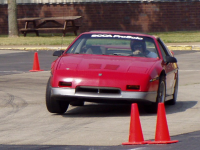Retrofitting WEEKE BP05
- Todd Zuercher
-

- Offline
- Platinum Member
-

- Posts: 4686
- Thank you received: 1433
Your count is a bit on the low side. (about 5-10x gear reduction would make tuning easier), You probably won't be able to count on accuracy better than about +-0.05mm (since one encoder count is 0.006375mm.) Not a deal breaker for a wood machine, but it can make tuning tough.
Please Log in or Create an account to join the conversation.
- db1981
- Offline
- Platinum Member
-

- Posts: 790
- Thank you received: 275
The main module I use is Beckhoff EM7004 4-Axis Interface + lots of DIns and Douts.
@Todd: The X Servo drives the ballnut per Belt, pinion is direct mounted on the workinghead, the rack on the machinebed.
The Resolution is 0.00625mm on my machines (Parameter from Num). Y and Z encoders are mounted on the motor shaft.
@urkee
normaly the Servos are all quiet. I think your Bias(DC Offset) is wrong. You can short both differential Inputs on the Indramats (or send 0V from your control) and then tune "Zero ADJ" Pots till the Servos are quit and stand still.
The other option is that your Capacitors are to old. You can measure the big ones with an ESR-Meter and change all the electrolytic tantalum capacitors on the control board in advance. On of my X-Axis Drive(TDM1) is in service, because it
had an problem on the input circuit. The drive needs some strange time to react on input changes.
sorry, i have not used my english for a few years. (reading is no problem)
Please Log in or Create an account to join the conversation.
- urkee
- Offline
- Junior Member
-

- Posts: 21
- Thank you received: 0
How big is the difference betwen 13,14,16 bit analog outputs and 16, 24 bit encoder conter is it going to affect pid tuning?
db i have tuned servos on zero adj. they are still, maybe the squeking because pid loop is not closed or some fault wiring by guy who retroffited to mach3, i'll wait untill i convert to linux cnc with new hardware, then if noise remain i will check capacitors.
Please Log in or Create an account to join the conversation.
- urkee
- Offline
- Junior Member
-

- Posts: 21
- Thank you received: 0
Please Log in or Create an account to join the conversation.
- PCW
-

- Online
- Moderator
-

- Posts: 17338
- Thank you received: 5050
How big is the difference between 13,14,16 bit analog outputs and 16, 24 bit encoder counter is it going to affect pid tuning?
Analog output resolution is not terribly important unless you have a very high performance system
This is because the input data to the PID loop is quantized fairly crudely by your encoder resolution
so anything better than about 12 bits will be fine.
There is no difference between 16,24, or 32 bit hardware encoder counters since all are extended to 32 bits (maybe 64 now)
in LinuxCNC
Please Log in or Create an account to join the conversation.
- jmelson
- Offline
- Moderator
-

- Posts: 512
- Thank you received: 123
This will make no difference at all. The more bits of analog output you have,m the finer the resolution of commanded speeds are available.Todd db is correct, i made two pictures to clear up. How do you calculate resolution?
How big is the difference betwen 13,14,16 bit analog outputs and 16, 24 bit encoder conter is it going to affect pid tuning?
For instance, a 16-bit DAC output allows 32,768 discrete speeds in the plus direction, and 32,768 speeds in the minus direction.
A 24-bit encoder counter just sums up the position of the axis, and at least the Pico Systems driver sign-extends the 24-bit counter to 32-bits
in the PC. That gives you a range of 4 billion encoder counts, 2 billion to the left of home and 2 billion to the right of home. That seemed enough for
most systems.
PID tuning couldn't really care about the difference in the number of bits here. First, one represents posiiton, the other represents velocity.
Secondly, all the internal calculationn of the PID is done in floating point format.
If you mean they make a steady whistling or whining noise, that may be because the PWM frequency of the servo amp is in the audible range. That would drive me crazy, I have sensitive ears.db i have tuned servos on zero adj. they are still, maybe the squeking because pid loop is not closed or some fault wiring by guy who retroffited to mach3, i'll wait untill i convert to linux cnc with new hardware, then if noise remain i will check capacitors.
Jon
Please Log in or Create an account to join the conversation.
- db1981
- Offline
- Platinum Member
-

- Posts: 790
- Thank you received: 275
-EK1100 Ethercat Coupler
-3xEL1008 24 D Ins
-3xEL2008 24 D Outs
-EM7004 16 DIn, 16 Dout, 4x Aout +-10V, 4x Encoder RS485,
-EL9505 5V PSU
Analog In for feed pot is not yet mounted.
Next Step is placing a few of the Ethercat Modules directly on the Head, to get place and to establish order in the cabinet. Also i will not need the 25years old chain cables anymore.
Please Log in or Create an account to join the conversation.
- urkee
- Offline
- Junior Member
-

- Posts: 21
- Thank you received: 0
You probably won't be able to count on accuracy better than about +-0.05mm (since one encoder count is 0.006375mm.) - Todd how do you calculate maschine resolution and acuracy for maschine with incremental encoders? can you show us formula?
db1981 thank you setup info. Do you run your weeke on linuxCNC or twinCUT CNC? What are 4 integrated incremental encoders in EM7004 modul for, have you used this option? I assume that with additional ethercat modules on head you can remove all cables for electrovalves, encoder feedback and limit switches and just energy cables will rest ? With analog-in you want to connect original feed pot on weeke cpanel? I got the original manual for encoder from balluf, you were wright it is 5V differential.
I got proforma invoice for complete setup BECKHOFF from local dealer, 845 eur + VAT on my doorstep.
Please Log in or Create an account to join the conversation.
- Todd Zuercher
-

- Offline
- Platinum Member
-

- Posts: 4686
- Thank you received: 1433
As to a formula, it is just adding up the range of all the tolerances.
What I was specifically addressing was that the distance between 2 quadrature encoder counts on your machine is the number of (encoder pulses) 4 = quad encoder count, then divide your mm/revolution by that, gives 51mm/8000=0.00675mm/count. Since PIDs are reacting on the error between commanded position and actual, the closest you can usually tune it to is plus or minus 2 or 3 encoder counts, and 4 is probably a more realistic number. So 4 times 0.00675 is 0.027 plus or minus. (sorry, last time did it all in my head and must have thought +\-.027is about .05 then wrote +\-.05)
Please Log in or Create an account to join the conversation.
- db1981
- Offline
- Platinum Member
-

- Posts: 790
- Thank you received: 275
Also i love the idea behind Linuxcnc much better than my closed systems at work. To write realtime components in real C is an very good option, also the other stuff (embedded)python etc.
Its very interesting for me, its wonderful the break the chains of the normal IEC PLC world.
The Encoders on the 7004 are the 3 Axis an one mpg (handwheel). with the additional ethercat on head, you can manage all sensors and actors... my encoder cables ends still in the cabinet, there is the em7004.
You can use single encoder interfaces (EL5101) instead of the em7004, and put them on the head.
Limit switches are in safty circuit, so you can't collect them on the bus, or you have to use "safty over ethercat", but its expensive. I connect all orginial buttons from my panel.
there is an user "Lavalu" who has also retrofitted his bp05, additional he wrote his own cam application for it. lcut.lavalu.de
Are you programmer or machine user?
Please Log in or Create an account to join the conversation.
